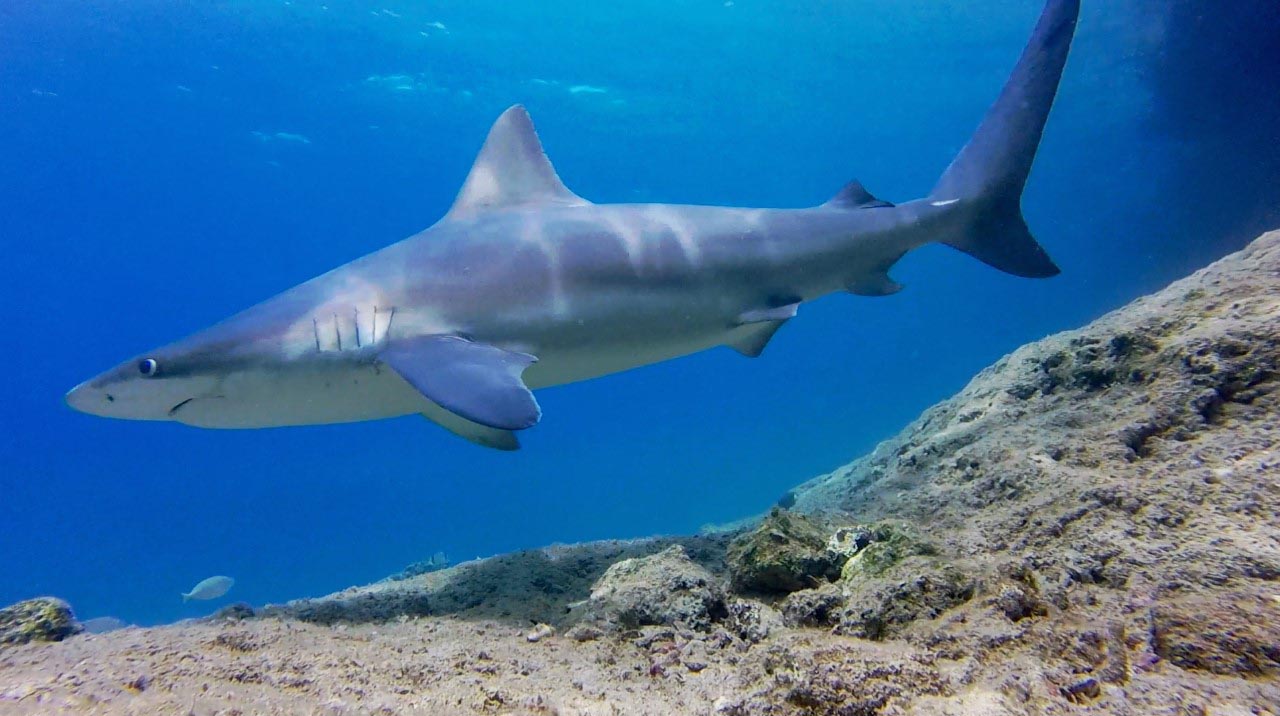
The sandbar shark (Carcharhinus plumbeus) is among the largest coastal shark species in the world. They reach about one and a half meters in length. With lifespans exceeding 30 years, they are among the long-lived creatures.
Despite their longevity, sandbar sharks are vulnerable species due to fishing pressure, low fertility rates, and other human-induced pressures. In the Red List published by the International Union for Conservation of Nature (IUCN), which shows the threat categories of species, the sandbar shark is classified as "Endangered (EN)" globally and in the Mediterranean Basin. Thirty-seven percent of shark and ray species in the world's waters are under threat.
Sandbar sharks have a cosmopolitan distribution, generally preferring continental shelves. They are found in temperate and tropical waters. They are common in bay mouths, ports, shallow muddy or sandy bays, and river mouths.
The sandbar shark, which also has a distribution in the Atlantic and Indo-Pacific oceans, has one of its breeding grounds in Boncuk Cove within the Gökova Bay. Therefore, Boncuk Cove became one of the seven "No Fishing Zones" declared in the Gökova Bay in 2010. Although sandbar sharks are species prohibited from fishing in our country, they are caught incidentally by fishing gear targeting other species.
While their distribution has been documented to reach depths of up to 280 meters, they generally occur at depths of around 100 meters.
They are viviparous species. Their gestation period lasts 9-12 months, and they can give birth to 1-14 pups. There is believed to be a positive relationship between the number of pups born in a breeding period and the size of the mother, with an increase in the number of pups as the mother's size increases. Although the sizes of newborn pups vary regionally, they are generally around 60-65 cm in length. Birth lengths in the Mediterranean are below average, ranging from 45-65 cm.
Sandbar Shark Distribution in Turkey
Despite being a large-bodied species, the sandbar shark is a relatively mild species. Their distribution includes all coastlines within the Mediterranean Basin except for the Black Sea and the Sea of Marmara.
For a region to be classified as a shark breeding area:
- 1. There should be a higher number of sharks compared to other regions.
- 2. Sharks should stay in this region for longer periods or show a tendency to return to the area.
- 3. The same region or habitat should be used repeatedly over the years.
The critical breeding areas for sandbar sharks are increasingly endangered due to human activities.
Bycatch is the greatest threat to sandbar sharks. Decreasing fish populations parallel to increasing fishing activities and the resulting fishing pressure can lead to the accidental capture of sandbar sharks, even if they are not the target species. Establishing and effectively managing protection measures for species and habitats are crucial for reducing this threat. The absence of bycatch records of sandbar sharks in recent years in Boncuk Cove, where protection and monitoring efforts are conducted, is an indicator of this.
The Mediterranean Conservation Society (MCS) has been working since 2013 to monitor sandbar sharks and preserve marine biodiversity in Boncuk Cove. The organization monitors the number of individuals, frequency of sightings, and behaviors of the species with a full-time camera system. Thousands of hours of footage are recorded and analyzed each year, and all observed data, including date, time, water temperature, and oxygen saturation, are processed to understand the effects of climate change on the species. Through the Marine Ranger System, MCS patrols Boncuk Cove and immediately informs relevant authorities when illegal activities are encountered. All monitoring activities are carried out with the permission and coordination of relevant public institutions.
Based on the research conducted on sandbar sharks, the International Union for Conservation of Nature (IUCN) has designated Boncuk Cove, located within Gökova Bay, as an Important Shark Area (ISRAs). Gökova Bay has been declared a relevant area (https://sharkrayareas.org/e-atlas/).
What is an Important Shark and Ray Area (ISRA)?
References
Compagno, L. J. V. (1984). Sharks of the world: an annotated and illustrated catalogue of shark species known to date. Rome: Food and Agriculture Organization of the United Nations.
Serena, F. (2005). Field identification guide to the sharks and rays of the Mediterranean and Black Sea. Rome: Food and Agriculture Organization of the United Nations.
Piercy, A. N., Carlson, J. K., Sulikowski, J. A., & Burgess, G. H. (2016). Historical occurrence of Carcharhinus spp. in the Sea of Marmara during the 1950s. Marine Biodiversity Records, 9(1), 1-5.
Fowler, S. L., Cavanagh, R. D., Camhi, M., Burgess, G. H., Cailliet, G. M., Fordham, S. V., … & Musick, J. A. (2005). Sharks, rays and chimaeras: the status of the chondrichthyan fishes. Gland, Switzerland: IUCN.
Saidi, B., Bradai, M.N., Marouani, S., Guelorget, O., Capape, C. (2006): Atypical characteristics of an albino embryo of Carcharhinus plumbeus (Chondrichthyes: Carcharhinidae) from the Gulf of Gabès (southern Tunisia, central Mediterranean). Acta Adriatica, 47(2): 167-174.
IUCN. (2012). IUCN Red List of Threatened Species. Version 2012.2. Retrieved from [http://www.iucnredlist.org]
Heupel, M. R., Carlson, J. K., & Simpfendorfer, C. A. (2007). Shark nursery areas: concepts, definition, characterization and assumptions. Marine Ecology Progress Series, 337, 287-297.
Florida Museum. (2023). Sandbar Shark. Retrieved from [https://www.floridamuseum.ufl.edu/discover-fish/species-profiles/carcharhinus-plumbeus/]






